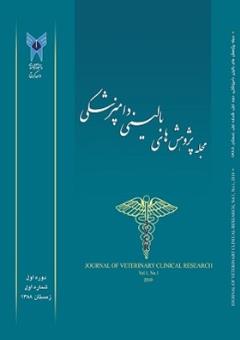Equine Colic Surgery: The Key Points to Be Considered
Subject Areas : clinical veterinary science
1 -
Keywords: Equine, Colic, Surgery,
Abstract :
After prompt referral to an equine hospital, surgical decision-making based on historical, clinical and diagnostic information would be crucial.
Understanding equine gastrointestinal anatomy is an important key to the diagnosis of an involved organ resulting in colic.
Equine colic surgery is a complex and significant procedure that requires a dedicated surgical team, inventive and experienced surgeons, and an equipped center.
Improving veterinary aftercare could be a means to further boost horse's performance and welfare after surgery.
1. Spadari, A., Gialletti, R., Gandini, M., Valle, E., Cerullo, A., Cavallini, D., Bertoletti, A., Rinnovati, R., Forni, G., Scilimati, N., et al. (2023). Short-Term Survival and Postoperative Complications Rates in Horses Undergoing Colic Surgery: A Multicentre Study. Animals, 13, 1107. https://doi.org/10.3390/ani13061107
2. Matthews, L. B., Sanz, M., & Sellon, D. C. (2023). Long-term outcome after colic surgery: retrospective study of 106 horses in the USA (2014-2021). Frontiers in veterinary science, 10, 1235198. https://doi.org/10.3389/fvets.2023.1235198
3. Kelmer, G. (2023). What do we currently know about incisional complications of colic surgery? Equine Veterinary Education, 35, 489–497. Available from: https://doi.org/10.1111/eve.13763
4. Straticò, P., Varasano, V., Palozzo, A., Guerri, G., Celani, G., Revelant, O., Petrizzi, L. (2002). Retrospective Study on Risk Factors and Short-Term Outcome of Horses Referred for Colic from 2016 to 2022. Veterinary Sciences. 9(10):545. https://doi.org/10.3390/vetsci9100545
5. Doherty, T. (2022). Chapter 32 - Anesthesia of Horses with Intestinal Emergencies (Colic). I: Doherty, T., Valverde, A., Rachel, A. Manual of Equine Anesthesia and Analgesia (Second Edition). John Wiley & Sons, Inc. 494-500
6. Marshall, J. F., Blikslager, A. T., Cook, V. L., Sherlock, C., Freeman, D. E., Southwood, L. L., Rakestraw, P. C., Prange, T. (2019). Chapters 33-38. In: Equine Surgery, 5th edn., Eds: J. A. Auer, J. A. Stick. W. B. Saunders, St Louis. 521-610.
7. Blikslager, A. T., N. A. White II, J. N. Moore, and T. S. Mair. (2017). The equine acute abdomen. Pages 1–782. T. S. Mair, ed. 3rd ed. John Wiley & Sons Inc., Hoboken, NJ.
8. Catherine, L. (2016). The veterinary nurse’s role in nursing an equine surgical colic patient, Veterinary Nursing Journal, 31:9, 276-279, DOI: 10.1080/17415349.2016.1206457
9. Wormstrand, B. H., Ihler, C. F., Diesen, R., & Krontveit, R. I. (2014). Surgical treatment of equine colic - a retrospective study of 297 surgeries in Norway 2005-2011. Acta veterinaria Scandinavica, 56(1), 38. https://doi.org/10.1186/1751-0147-56-38
10. Findley, J., & Archer, D. (2014). Management of the surgical equine colic patient following hospital discharge. In Practice, 36(5), 229–237. doi:10.1136/inp. g2739
11. Boesch, J.M. (2013). Anesthesia for the horse with colic. Vet. Clin. North Am. Equine Pract. 29: 193 - 214
12. Singer, E. R., & Smith, M. A. (2010). Examination of the horse with colic: is it medical or surgical? Equine Veterinary Education, 14(2), 87–96. doi:10.1111/j.2042-3292. 2002.tb00147.x

